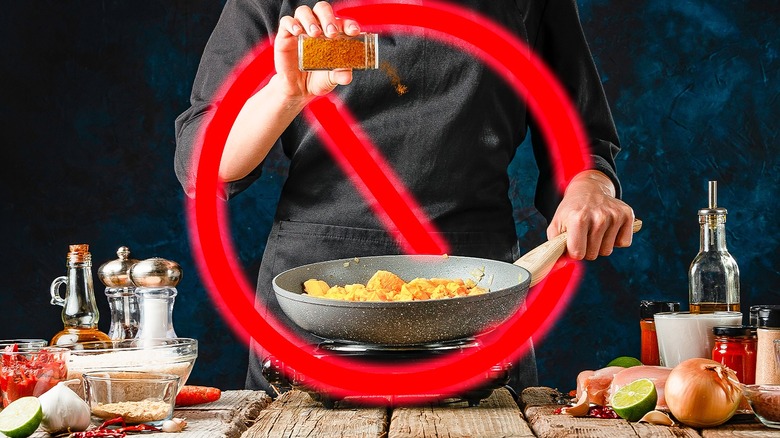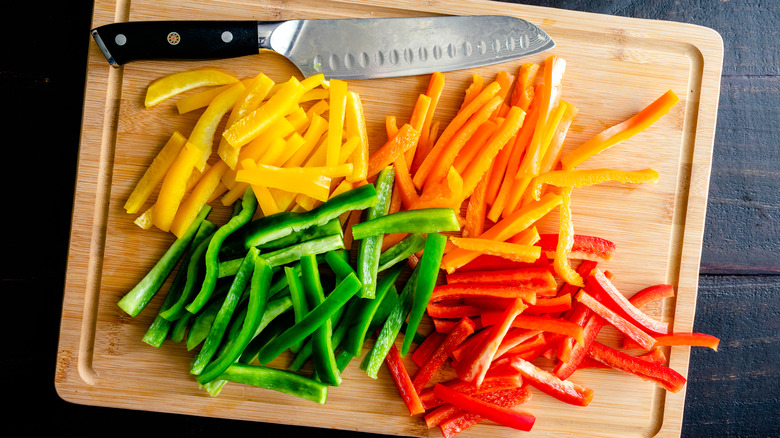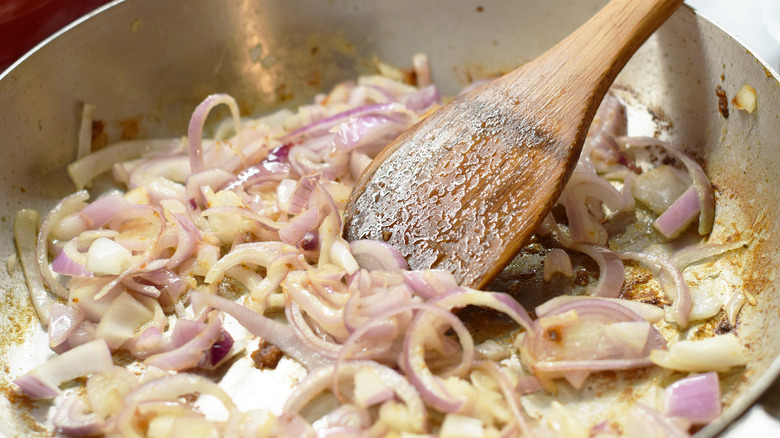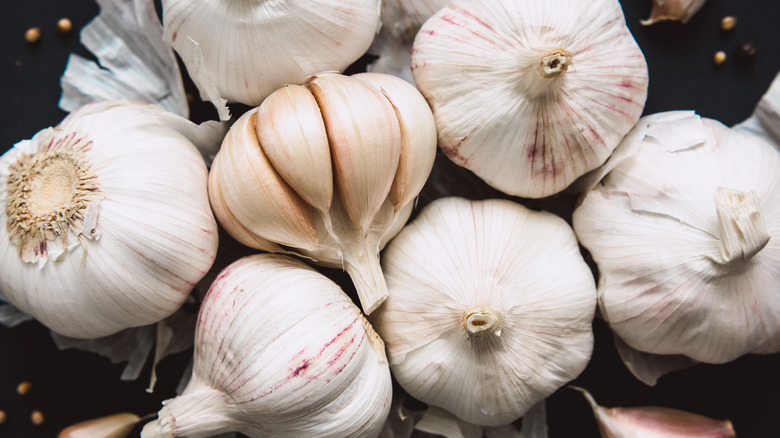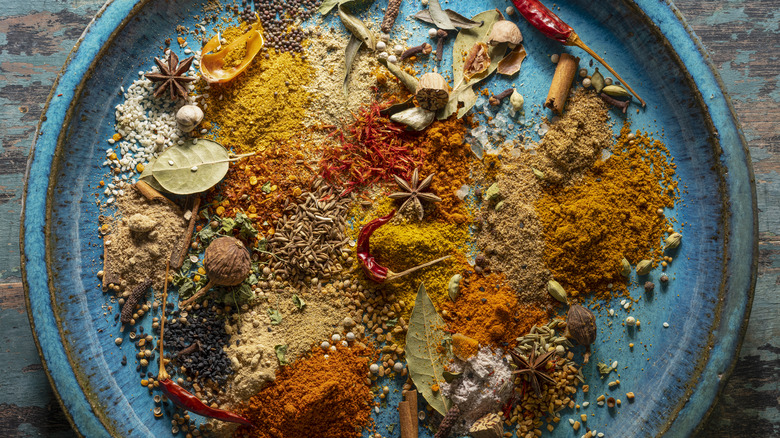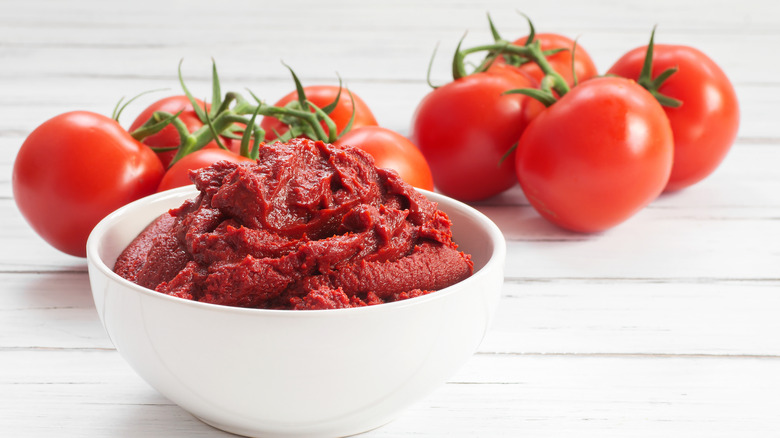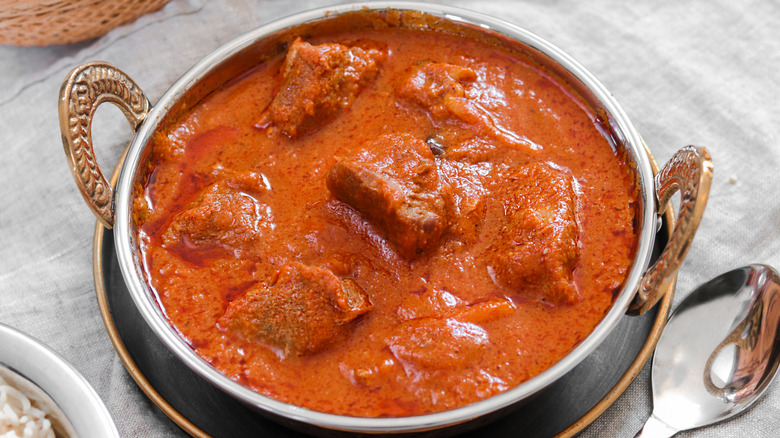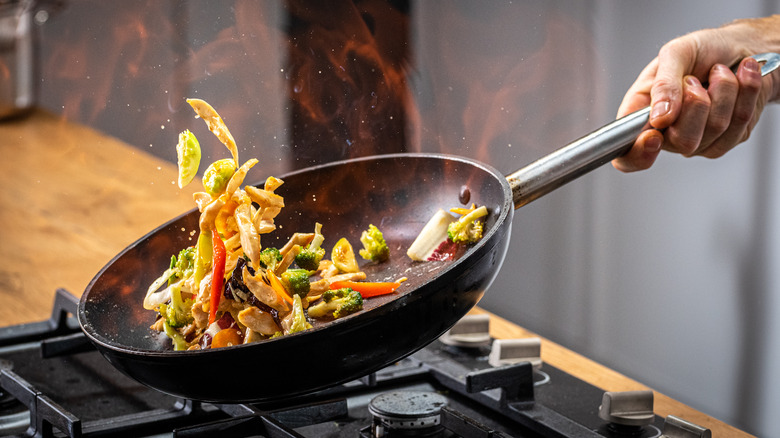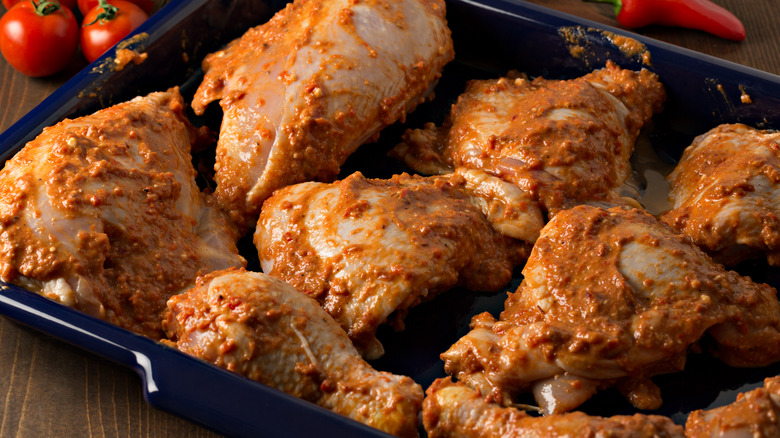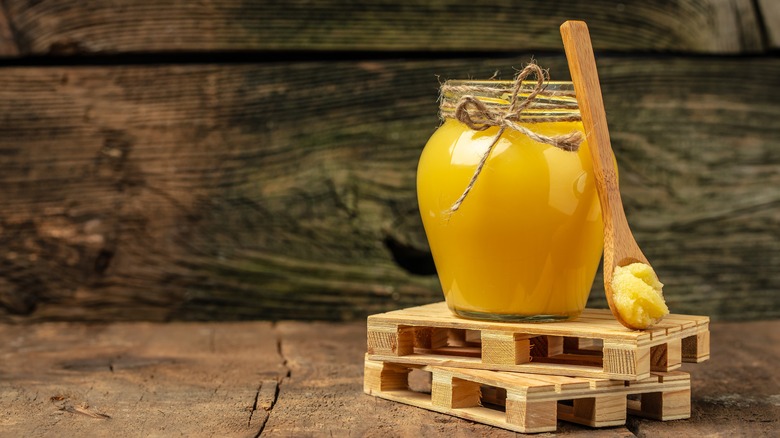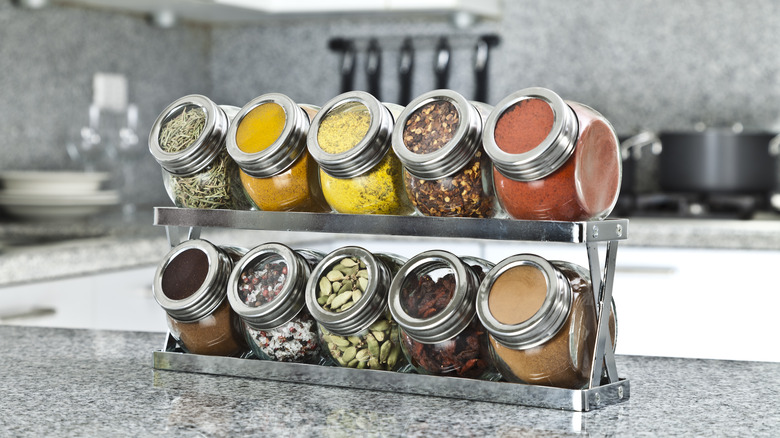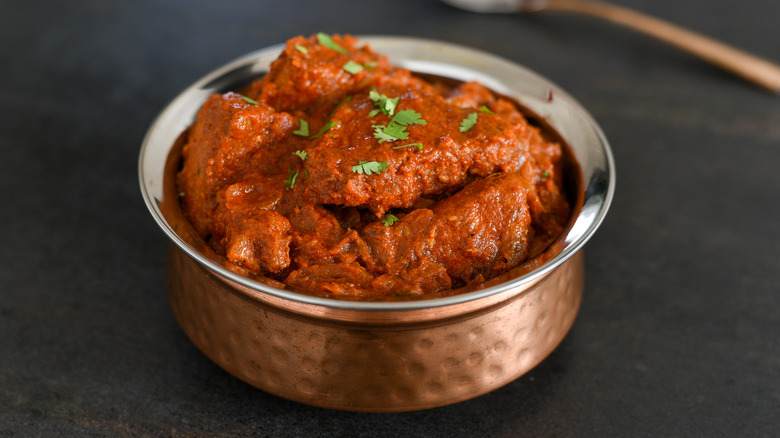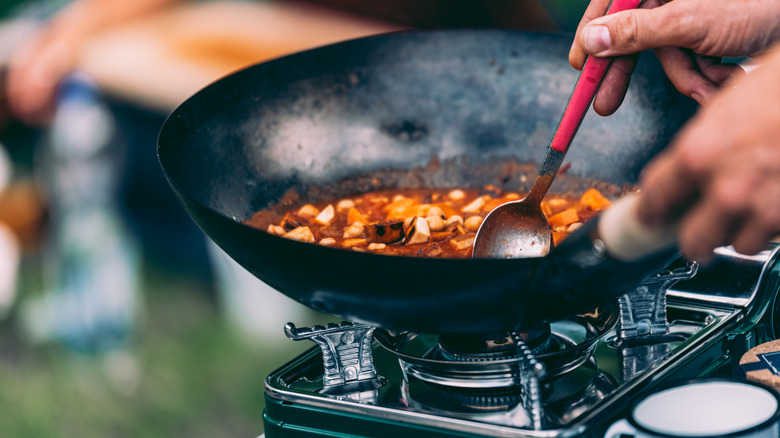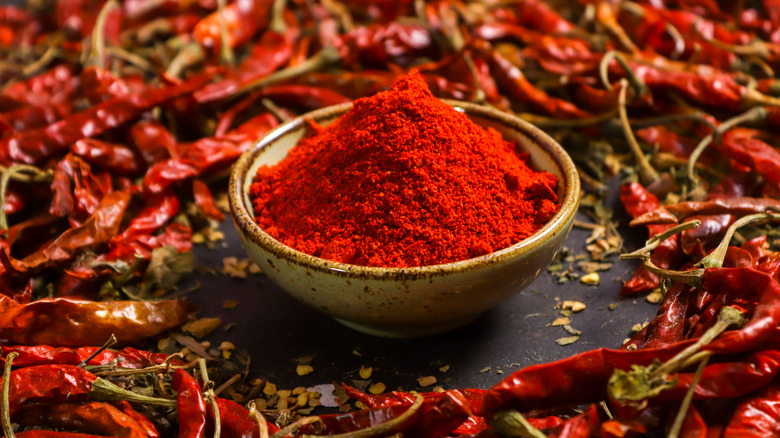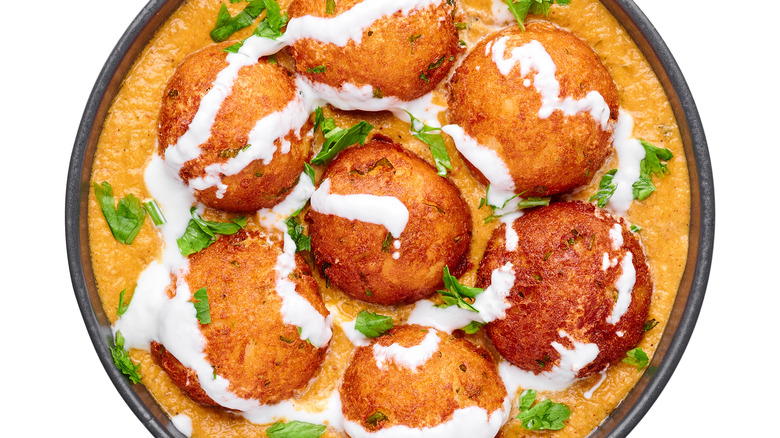14 Mistakes You Need To Stop Making With Curry
Curry is a food that you can't help but fall in love with. Whether you're eating a fiercely-hot Thai curry, an Indian curry that's bursting with a complex balance of spices, or a South African curry stuffed into a loaf of bread known as bunny chow, the combo of simmered meats and vegetables and deep flavors is a winner every time. Curry has a long and complex history, and in India, its development has been influenced by a wide range of colonial influences. From generation to generation, different styles of curry and blends of flavors developed. And now, in Indian restaurants across the world, you can find an enormous range of curries, each with its distinctive taste, heat, and ingredients.
So it's no wonder that, for the novice chef, making a curry can seem intimidating. With all those passed-down techniques and nuggets of wisdom serving to perfect the dish, how can you get it right the first time? The truth is that learning to make a good curry takes patience, dedication, and practice — no shortcuts here, folks. But you can take your curry game up a notch by avoiding some all-too-frequent mistakes that will turn your meal into a watery, flavorless disaster.
Not preparing your ingredients ahead of time
While some curries can be cooked gently and slowly, simmering away on the stove for hours, others are cooked and on the plate in the blink of an eye. And given that some curries require you to move quickly, not having your ingredients prepared before you start cooking will cause hiccups. Having your vegetables and meat fully chopped and ready to be added to the pan will stop you from having to do so hurriedly while the rest of your food burns in the pot, saving you huge amounts of stress and having to start again from scratch.
This is never more important than with your spices. If you've made a proper curry before, you'll know that the flavors largely come from the intricate balance of spices added to the dish. But we can guarantee you that once you start cooking, you won't have time to be measuring out a quarter teaspoon of nine different things. Measure them out before separating whole spices and ground spices, and pop them in ramekins next to your pot, so they can be thrown in at the right time. Make sure that you have all of your cooking utensils to hand, too, so you're not caught off guard at any point.
Cooking your onions incorrectly
Most curry recipes start with an onion or two, and the root vegetable adds a key bass note to the dish that can't be replicated elsewhere. But cook your onions wrong, and you'll ruin your meal before you've even started. The first thing to remember is where onions come in the order of things with curry, which is firmly at the beginning. While some curries, like kormas or masala curries, may boil their onions, the majority of recipes require you to sweat your onion gently in fat until they're soft, clear, and lightly browned. Slice or dice your onions, and sauté them for 5-10 minutes before adding anything else.
When doing this, make sure you watch out for another key mistake: Burning your onions. If you cook your onions for just a minute or two too long, they'll start to blacken and develop an acrid flavor. There's no going back from this point, folks. If you try to forge on with your curry, you'll end up with a bitter result. If you do this, it's far better to just toss your onions out and start again. Just make sure you pick up an extra few at the store, just in case.
Burning your garlic
We're just gonna say what everyone's thinking: Garlic is kind of a diva. Yes, this tiny vegetable adds a punch to your dish that can't be replaced, but step away from it for one second, and it burns, ruining all your hard work in the process. Needy, much? The reason garlic burns so quickly is that it's a relatively dry plant. This low water content means that it doesn't have a buffer in the way that other vegetables do to burning, which releases water that stops them from blackening.
As such, one key mistake that people make — and which, unfortunately, many recipes guide them to make — is to add their garlic right at the start while sweating their onions. This is much longer than garlic needs to cook, especially finely-minced cloves, which might only need 30 seconds or so. Instead, add your garlic when your onions are almost fully cooked and just before you add the rest of your ingredients. Doing this will ensure that they don't make your curry taste burnt and nasty but instead deliver that juicy hit of umami that we all crave.
Using the spices incorrectly
If you have limited experience with spices, it's very easy to treat them all the same. After all, they all similarly add flavor, so why should they require special treatment? But if you're adding your whole spices into your cooking liquid or putting your ground spices in with your onions, you're on your way to serving up a strange-tasting mess.
Spices in most curries can be divided into two different categories: Whole and ground. Whole spices are unprocessed, and many, like cumin and mustard seeds, show up time and time again in curry recipes. The key to these spices is to add them at the start of your cooking process so that they can roast and fry. By doing this, they release a deep, intense flavor that gives your curry an essential layer that can't be fully achieved with ground spices.
Ground spices, on the other hand, give a slightly lighter flavor. But while they also need to be cooked, their powdered nature also means that they're pretty susceptible to burning. It's best to add ground spices just before you add any wet ingredients so that they have a chance to cook quickly. The one exception to this rule is garam masala. A spice blend made from toasted, ground spices, this already-cooked mixture should be added at the end of a curry to give the dish a boost of flavor and complexity.
Adding tomato puree straight out of the can
A huge amount of curries are tomato-based, and tomato puree is often used instead of fresh tomatoes to achieve a more intense flavor. Although some recipes might state that you should use tinned or chopped tomatoes, using tomato puree is often way more authentic and won't water down your curry sauce.
However, novice chefs can often burn their tomato puree by adding it straight into the pan. Tomato puree is pretty acidic, and unless you want a rather bitter taste threading through your curry, you should always dilute it first. Diluting tomato puree also means that the spices that you've likely just added won't burn and will instead become flavorful and aromatic.
To dilute tomato puree, you might need to add slightly more water than you think. You should generally add about twice the amount of water to your puree; if you're adding a quarter-cup of puree, add a half-cup of water, for example. This will give the tomato puree enough moisture to gently simmer and sweeten instead of burning. And some of the liquid will also cook off, so things don't get too watery.
Forgetting to use a curry base
We're gonna let you in on a little secret. The reason that Indian restaurants can crank out delicious curries so quickly is not because they're working double-time in the kitchen, although they may well be on a busy night — it's because of a secret ingredient that you should definitely be using too. A premade base is a blended combination of cooked vegetables and spices, which is stashed in the fridge or freezer until ready to use. Add it at the start of making your curry, and you'll get an instant boost of flavor that saves serious time.
To make a curry base, you'll need a lot of onions, some red and green pepper, ginger garlic paste, and some spices. Sweat your onions in a large pot, then add your vegetables and spices, and boil the whole thing down, ideally in a pressure cooker if you have one. Then, blend everything using a hand blender until you have a fairly thick, smooth paste. Use it straight away, or bag it up and stash it in the deep freeze until your next curry night. Then defrost, dilute slightly, and throw it into your next korma or madras.
Not frying your ingredients for long enough
Think of curry, and you'll likely think of a steaming, simmering pot full of aromatic and delicious ingredients being boiled to perfection. But while curries spend a large part of their cooking process being cooked through wet heat, if you're neglecting frying your meat and vegetables for enough time beforehand, you're missing out on valuable flavor.
By frying the main components of your curry, such as the onions and meat or protein you're using, you give them a chance to undergo the Maillard reaction. This key principle in cooking is what gives so many different types of food its flavor. The Maillard reaction occurs when food reaches a certain temperature in a hot pan when the sugars and amino acids in the foodstuff change structure. This is what leads to food browning and what gives it its newly complex flavor. Or, in layman's terms: If you don't brown your meat, it won't taste of anything. And this taste will then work its way through the rest of your curry, giving the whole thing even more flavor.
There's a fine line between browning and burning, so make sure you keep an eye on whatever you're frying at all times. And, crucially, remember that food can't brown if it's wet, so keep your liquids away until everything's looking sufficiently bronzed.
Forgetting to marinate your meat
If you're using meat, you want it to be the star of the show in a curry. Sure, that sauce is going to be an all-important flavor vehicle, but the dish isn't going to pop unless your meat is full of flavor and properly seasoned, too. And one of the best ways to do this in a curry is to marinate your meat before you cook it. By giving your meat time to marinate before making curry, you give all of the flavors in the marinade a chance to work their way into the protein, both tenderizing the meat and making it even tastier.
Marination is an essential step in any curries that have the word tikka in them, like chicken tikka masala, with the word referring to the marinating process. For curries, yogurt marinades tend to be the most traditional and impart the most taste, although lemon juice and vinegar can also be used to soften and flavor meat. Adding spices, chili powder, and seasonings to a marinade can give the meat additional flavor, ensuring that your curry is flavored from the outside in.
Using any fat that isn't ghee
If you want a premium curry, you need to use good fats. But so many people, despite buying the most expensive spices and meat that money can buy, still resort to using vegetable oil when it comes to frying. By opting for ghee, though, you'll make restaurant-level curries every time.
Ghee is the fat of choice in many Indian dishes and is made by clarifying butter, cooking it until all that's left is the fat and none of the milk solids. Ghee is primarily useful on a chemical level, as it has a way higher smoke point than other fats, which allows you to cook at the fierce temperatures that making a curry requires. But it also adds an all-important flavor note that gives curries their distinctive richness.
"Vegetable oils tend not to have a flavor, so by using ghee you're not only using it as a fat but you're also adding that kind of buttery flavor to it," says head chef and restaurant owner O Tama Carey to ABC. Using ghee might be intimidating to first-timers, but you can employ it like pretty much any other fat or add it to a base sauce to impart that buttery richness easily.
Using old spices
A full selection of spices is an absolute must for your pantry if you're making curry. And as spices come in dried, jarred, and often ground form, they tend to have a pretty long shelf-life. A common error, however, is assuming that your spices will last way longer than they do. The reality is that, like all foods, spices lose freshness over time, primarily due to oxygen exposure. And this can impact their flavor and how your curry eventually turns out.
Ground spices are the quickest to go off; most will last about six months or so before they're past their best. Whole spices tend to fare much better and have a significantly longer shelf life, with some still being usable up to five years after you've bought them. Old spices usually won't pose any risk to your health if you eat them, according to Healthline. But they will be much, much weaker than they were when you originally bought them and may end up adding no additional taste or fragrance to your food.
The best way to test whether spices are still fresh is by employing your nose. If your ground spices have a weak aroma or don't smell like anything at all, it's usually the case that you should buy a new jar. Whole spices can be harder to check in this way, but check to see if they look pale or faded — if they are, they may be done.
Overseasoning your curry
The spices in curry do a lot of heavy lifting flavor-wise. But to tie everything together and bring out each taste, you'll need to add salt. As with all foods, though, it's very easy to get the salt balance wrong with curry and throw in too much, leaving you and your guests gasping for a glass of water after your meal.
Luckily, if you have time on your side, an over-salted curry is easily fixed. Adding a peeled, sliced root vegetable into the pot is a nifty trick. Sliced raw onions or potatoes will soak up excess salt if you leave them in your mixture for 15-20 minutes, and then all you have to do is readjust the balance of liquids that may have been absorbed from the sauce and serve up.
Adding an additional flavor element into the curry, like acid through a spritz of lemon juice or creaminess from yogurt or cream, can also dilute any unwanted saltiness. And if your curry is too thick, as well as too salty, a splash of water will diffuse some of that brininess.
Watering things down too much
Curries, as we know them, are typically pretty liquid-heavy dishes, although it's useful to remember that dry curries, which have barely any sauce, are as delicious as the stew-like wet ones. But there's a fine line between a curry sauce of perfect thickness and finely-calibrated flavors and a thin, watery sauce that tastes of not very much at all.
Adding too much liquid is a common mistake with curry. And while adding broth or dairy may provide more flavor than water, it'll still dilute the balance of flavors you've so lovingly created. While it might not be a strictly traditional approach, adding a thickening agent like cornflour or regular flour can tighten up a sauce. Spooning in a bit of tomato puree can also add bulk to your sauce while also adding flavor.
If your curry doesn't include too many vegetables or things which are at risk of being overcooked, you can also just let it simmer for a little bit longer so that some of the excess liquid evaporates. Whichever method you choose, ensure that you're doing a taste test of the curry before you serve it to adjust any flavors that might have been thrown off-kilter by making it thicker.
Adding too much chili
Ah, yes, we've all been there. Suddenly overcome with passion in the kitchen, we've all had that moment of pouring an ingredient in by hand and adding in just a little more than you usually do. Who needs recipes or restrictive measurements? You're an artist.
This creative flair is all well and good, but when you're adding too much chili, you could be in for a painful experience. An overly-spiced curry is one of the more unpleasant dining experiences — but thankfully, there are ways to cool things down. Throwing in a dairy element is a great way to temper the fierceness of chili and stop everything from being too spicy. The casein in yogurt, cream, and milk can stop the chemical in chilis, known as capsaicin, being so painful, providing a cooling effect to the mouth, says the Cleveland Clinic.
Other components, like lemon juice, can also cut through spiciness and rebalance flavors. Finally, a good way to diffuse heat while also making more curry is just to add a bit more of your other ingredients, like additional vegetables or meat. More leftovers? We like the sound of that.
Forgetting the finishing touches
One of the best things about curry is its sheer homeliness. This is a meal that is designed to be poured into a bowl and eaten with piles of flatbread or rice, so you really don't have to worry too much about presentation. One way to make a curry extra special, though, is to consider the finishing touches. For added visual flair, you can't go wrong with a scattering of chopped coriander, which can provide some all-important green to the dish, while also giving a pop of fresh, floral, slightly spicy flavor.
A squeeze of lemon juice added at the end of your cooking process can brighten up your curry, cutting through any density that the sauce may have developed while it was simmering. Garam masala is also your best friend when the meal is almost done, and while your recipe may call for adding it into the pot at the end, try scattering a little extra over the top of each bowl. Finally, if you want your curry to taste extra luxurious, try adding in a swirl of heavy cream just before you serve it. This will not only make it richer but will also mellow out any heat it may have developed.
